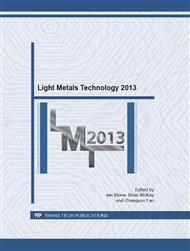[1]
A. Chapuis, J.H. Driver, Temperature dependency of slip and twinning in plane strain compressed magensium single crystals, Acta Mater. 59 (2011) 1986-1994.
DOI: 10.1016/j.actamat.2010.11.064
Google Scholar
[2]
M.M. Avedesian, H. Baker, Magnesium and Magnesium Alloys (ASM Specialty Handbook), ASM International, Materials Park, 1999.
Google Scholar
[3]
E.W. Kelly, W.F. Hosford, Deformation Characteristics of Textured Magnesium, Trans. Met. Soc. AIME 242 (1968) 654.
Google Scholar
[4]
S.R. Agnew, O. Duygulu, Plastic anisotropy and the role of non-basal slip in magnesium alloy AZ31B, Int. J. Plasticity 21 (2005) 1161-1193.
DOI: 10.1016/j.ijplas.2004.05.018
Google Scholar
[5]
P. Dobroň, F. Chmelík, S.B. Yi, K. Parfenenko, D. Letzig, J. Bohlen, Grain size effects on deformation twinning in an extruded magnesium alloy tested in compression, Scripta Mater. 65 (2011) 424-427.
DOI: 10.1016/j.scriptamat.2011.05.027
Google Scholar
[6]
M. Friesel, S.H. Carpenter, Determination of the Source of Acoustic Emission Generated during the Deformation of Magnesium, J. Acoust. Em. 6 (1984) 11-18.
Google Scholar
[7]
B. Clausen, C.N. Tome, D.W. Brown, S.R. Agnew, Reorientation and stress relaxation due to twinning: Modeling and experimental characterization for Mg, Acta Mater. 56 (2008) 2456-2468.
DOI: 10.1016/j.actamat.2008.01.057
Google Scholar
[8]
M.A. Gharghouri, G.C. Weatherly, J.D. Embury, J. Root, Study of the mechanical properties of Mg-7.7at.% Al by in-situ neutron diffraction, Philos. Mag. A 79 (1999) 1671-1695.
DOI: 10.1080/01418619908210386
Google Scholar
[9]
Information on: http://neutron.ujf.cas.cz/meredit
Google Scholar
[10]
O. Muránský, D.G. Carr, P. Šittner, E.C. Oliver, In situ neutron diffraction investigation of deformation twinning and pseudoelastic-like behaviour of extruded AZ31 magnesium alloy, Int. J. Plasticity 25 (2009) 1107-1127.
DOI: 10.1016/j.ijplas.2008.08.002
Google Scholar
[11]
J.W. Christian, S. Mahajan, Deformation Twinning, Prog. Mater. Sci. 39 (1995) 1-157.
Google Scholar
[12]
I.I. Papirov, E.S. Karpov, M.I. Palatnik, M.B. Mileshkin, Acoustic-Emission during Plastic and Superplastic Deformation of a Zn-0.4-percent Al-Alloy, Met. Sci. Heat Treat. 26 (1984) 887-891.
DOI: 10.1007/bf00801000
Google Scholar
[13]
S.H. Carpenter, C.M. Chen, The Acoustic Emission Generated during the Plastic Deformation of High Purity Zinc, J. Acoust. Em. 7 (1988) 161-166.
Google Scholar


